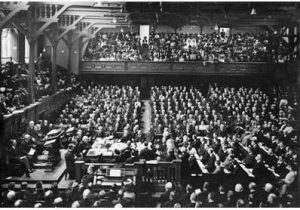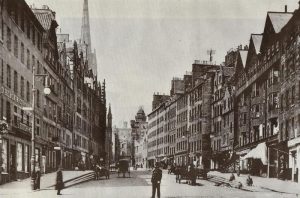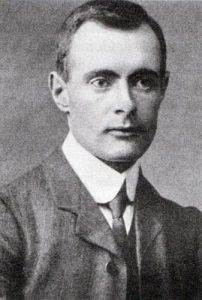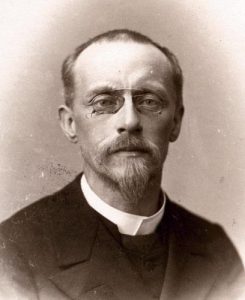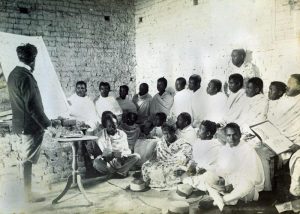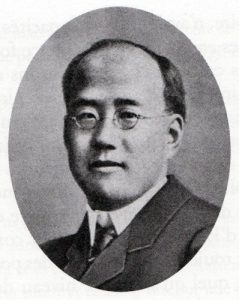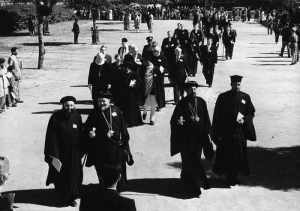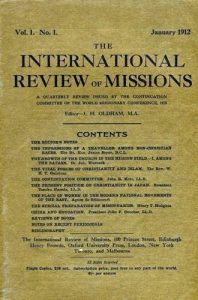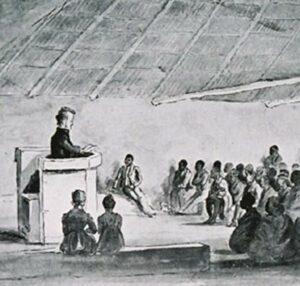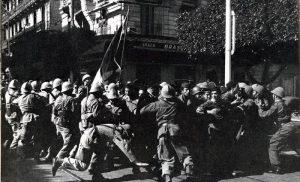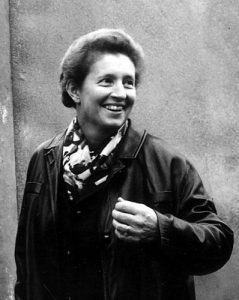The First World Missionary Conference
Four major missionary conferences had worked at preparing the coordination of Anglican and Protestant missionary societies ; they took place in the following cities :
• Liverpool (1860)
• London (1878 and 1888)
• New York (1990)
However in Edinburgh there were only the official representatives of different missionary societies ; their directors, their missionaries and the members of their auxiliary committees. The conference had been carefully prepared by eight commissions who each worked for two years on their assigned topic.
Only Anglican and Protestant missionary societies had representatives. Although there were none from the Catholic or the Orthodox Churches, the latter were mentioned with respect several times during the proceedings. Most representatives were Anglicans or Americans.
Why choose Edinburgh ?
Scotland considered the work of missionary societies to be of great importance : it had sent out such renowned missionaries as David Livingtone and established well-known missions throughout the world. What’s more, these missionary societies received strong support from home and so it was quite feasible for Scotland to take on the organisation of something as impressive as a world conference.
On 14th June 1910, 1215 delegates gathered in the Assembly Hall of the United Free Church of Scotland for the first session, under the presidency of Lord Balfour , one of the most well known members of the Church and a former cabinet minister. The Conference lasted ten days, until the 23rd June. Everybody in the city was involved in this event, due to public lectures which were held every day and the delegates were welcomed by the Civic Authorities.
The preparation
An international committee was held in Osvord in 1907 : there were ten British, five North American and three European representatives. At the head of this movement were the American John Raleigh Mott and the Scot John Houldsworth Oldham.
John Mott’s watchword for the Conference was « The Evangelisation of the World in This Generation ». However, later this changed to « A Consideration of the Problems facing Missionary Societies in the Non-Christian World. »This was to avoid any conflict between Protestant missions and countries which had already been evangelized by the Roman Catholic or Orthodox Churches.
Delegation was based on pragmatic grounds : the missionary society could only send a delegate if it supported a mission abroad and if is annual expenditure was at least 200 pounds. For a sum of 400 pounds, another delegate could be sent. 176 missionary societies sent delegates : 59 from North America, 58 from the Continent, 47 from the United Kingdom and 12 from south Africa and Australia.
The subjects to be discussed at the Conference were prepared by eight commissions. The committee established a questionnaire for each commission which was sent to missionaries all over the world. A thousand completed questionnaires were returned to the commissions to be taken into consideration.
The French delegates
Out of 1215 delegates, there were more than a thousand from Britain or America compared to only 170 from the rest of Europe.
The French delegation consisted of 10 members from the Société des Missions Evangéliques de Paris : they were the director Alfred Boegner, a certain number of missionaries serving abroad and representatives from the auxiliary committees. The French delegates felt they were part of a historic event and were joining forces with « those who had set out to conquer the world». However the large number of Anglo-Saxon delegates brought it home to them that they were almost powerless to undertake such a momentous missionary task. None of the French delegates had been asked to join the preparatory commissions and Alfred Boegner was the only one to be invited to give a lecture in English. This was on the evening when he launched an appeal : « Help us to evangelize ».
The agenda
The agenda stipulated that the most important part of the daily programme was the common prayer of intercession which was held regularly at midday. However, most of the time was spent discussing the reports drawn up by the commissions :
I – Carrying the Gospel to All the Non-Christian World
II – The Church in the Mission field
III – Education in Relation to the Christianization of National Life
IV – The Missionary Message in Relation to Non-Christian Religions
V – The Preparation of Missionaries
VI – The Home Base of Missions
VII – Missions and Governments
VIII – Co-operation and the Promotion of Unity
Those who wanted to participate in one of the discussions had an allotted time of up to seven minutes.
Every evening the delegates listened to two or three lectures ; however, these did not form part of the commissions.
Co-operation and the Promotion of Unity
The most impressive speech was made by the Chinese delegate Cheng Ching Yi during the discussion on the report made by commission VII . There were only fifteen Asian delegates representing the non-western world. There were no Africans, Latin-Americans or delegates from the South Pacific. This was because the missionary societies could sent delegates but not the Churches that were the fruits of their work.
The Chinese delegate talked of the Christian Federation of China which had developed inter-Christian co-operation in the realms of education and evangelization « in order to establish in the near future a united inter-denominational Christian Church ».It is due to these words that the 1910 Conference in Edinburgh has been considered as the basis of the Ecumenical Movement.
The Continuation Committee
The Edinburgh Conference did indeed achieve its aim of developing missionary co-operation within an official and organized framework ; however, the only actual decision they made was to set up a Continuation Committee to continue the work with 35 members under the leadership of John Mott and J.H.Oldham in 1921. In the years following the First World War, the Committee developed into the International Missionary Council with one headquarters in London and another in New York ; it consisted of many missionary societies and international Christian organisations of all denominations in the mission field.
It organized the international conferences in Jerusalem (1928), Tambaram in India(1938), Whitby in Canada (1947), Willingen in Germany (1952) and Achimota in Ghana (1958). In 1961, it became the World Commission for Mission and Evangelization organized by the World Council of Churches (WCC). This was in New Delhi, when the African Churches resulting from the missionary societies work (who became fully independent towards the end of the 50’s) were received into its midst ; there were also several Orthodox Churches including the Russian Orthodox Church.
The beginning of the Ecumenical Movement ?
The 1910 Edinburgh Conference has been considered by some as the beginning of the Ecumenical Movement. It is true that for the first time the Church had its place on a worldwide map ; indeed, for a great many delegates, it was obvious that Christianity was shortly to become a world religion. This is why the Edinburgh Conference was an important event in the religious history of the 20th century.

